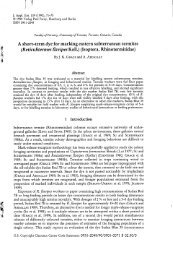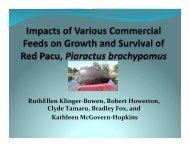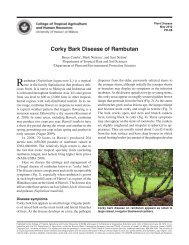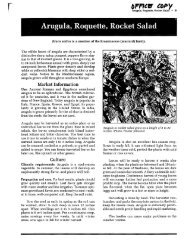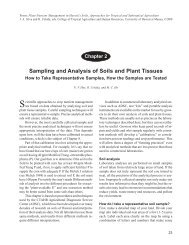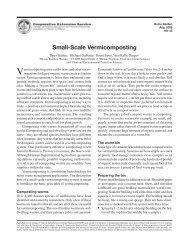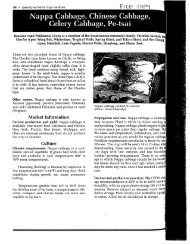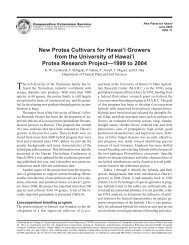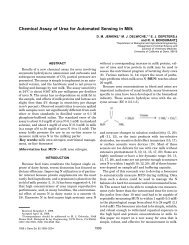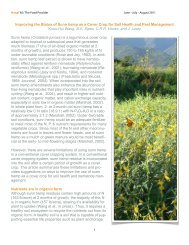Macadamia Nuts in Hawaii: History and Production - ctahr ...
Macadamia Nuts in Hawaii: History and Production - ctahr ...
Macadamia Nuts in Hawaii: History and Production - ctahr ...
Create successful ePaper yourself
Turn your PDF publications into a flip-book with our unique Google optimized e-Paper software.
Figure 76. Rat-damaged nuts under a tree that was isolated <strong>and</strong><br />
poorly ma<strong>in</strong>ta<strong>in</strong>ed. Rats gnaw through the outer hard<br />
shell, creat<strong>in</strong>g an open<strong>in</strong>g through which they are able to<br />
reach the nutmeal.<br />
Figure 77. Rat bait stations made of cans with a lip bent up on the<br />
lower open<strong>in</strong>g to reduce ra<strong>in</strong>water fall<strong>in</strong>g on the bait.<br />
58<br />
are self- or cross-compatible. Although honeybees<br />
do help <strong>in</strong> poll<strong>in</strong>ation, evidence <strong>in</strong>dica tes tha t bee<br />
population from a given apiary rapidly decl<strong>in</strong>es<br />
with distance from the hive (15). However, no<br />
suggestions as to the distance between apiaries <strong>in</strong><br />
an orchard or the number of hives necessary per<br />
acre can be given at this time. Until reliable data<br />
on the macadamia nut becomes available, the beehives<br />
<strong>in</strong> the orchards should be clustered to make<br />
placement easier, at the rate of about one hive per<br />
acre. The density of hives can then be changed as<br />
further <strong>in</strong>formation becomes available. Syrphid<br />
flies <strong>and</strong> other <strong>in</strong>sects also aid <strong>in</strong> poll<strong>in</strong>ation (85).<br />
Consequently, any <strong>in</strong>secticidal spray program<br />
should be closely monitored dur<strong>in</strong>g the flower<strong>in</strong>g<br />
season.<br />
Honey from macadamia blossoms is considered<br />
excellent.<br />
Flower<strong>in</strong>g <strong>and</strong> Nut Set<br />
The macadamia flower cluster is a raceme (16)<br />
with 200 or more perfect flowers, each on its own<br />
pedicel, arranged along the sides of a common<br />
flower stalk. Each raceme extends to its fullest<br />
development before the buds beg<strong>in</strong> to open at<br />
r<strong>and</strong>om throughout the cluster. The flowers stay<br />
open for a few days, dur<strong>in</strong>g which time most of the<br />
poll<strong>in</strong>ation takes place. Some flowers have their<br />
own pollen capsules attached to the stigmatic<br />
surface, <strong>and</strong> are self-poll<strong>in</strong>ated. Although no data<br />
have been collected, visual <strong>in</strong>dications are that<br />
only about 10 percent or fewer of the racemes<br />
formed on the tree will eventually produce harvestable<br />
nuts. Initial fruit set on these racemes is<br />
generally heavy, but for causes not yet determ<strong>in</strong>ed,<br />
some young fruits up to \4 <strong>in</strong>ch (0.5 centimeter) <strong>in</strong><br />
diameter will drop very early, leav<strong>in</strong>g only a few<br />
nuts to mature on a sett<strong>in</strong>g raceme. When the nuts<br />
are much larger, "June drop" occurs dur<strong>in</strong>g the<br />
summer months, further reduc<strong>in</strong>g the harvestable<br />
nut set. Experiments on the effect of the growth<br />
regulator succ<strong>in</strong>ic acid 2,2-dimethylhydrazide<br />
(SADH) have been conducted (50, 59). Results of<br />
these trials us<strong>in</strong>g 1O-ppm solutions have shown a<br />
10 percent nut set <strong>in</strong>crease without affect<strong>in</strong>g nut<br />
quality, growth, or m<strong>in</strong>eral nutrition of leaves.<br />
However, more research <strong>in</strong> this area is needed.<br />
Flower<strong>in</strong>g normally occurs dur<strong>in</strong>g the period<br />
from November through February <strong>in</strong> <strong>Hawaii</strong>; the<br />
nut harvest period starts about August of the<br />
follow<strong>in</strong>g year <strong>and</strong> cont<strong>in</strong>ues until about February<br />
or March. In older trees, however, flower<strong>in</strong>g can



